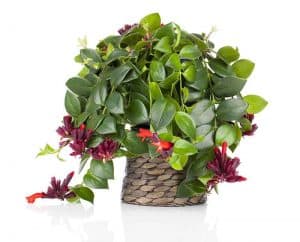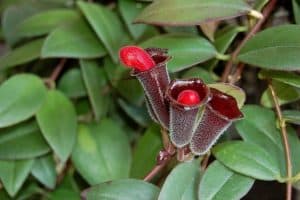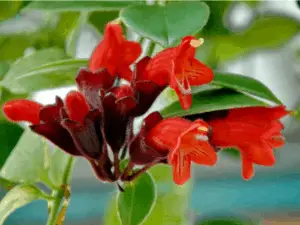What is the Lipstick Plant?
The lipstick plant is a genus of about 150 species of evergreen subtropical plant and lies in the family Gesneriaceae. It has various names like aeschynanthus, lipstick basket vine, and basket vine and is native to the humid tropics of Malaysia and Indonesia. They are usually trailing epiphytic plants having bright flowers. Sunbirds generally pollinate them.
There is a large variety of plants with different features under this genus. Some of the plants have thick, waxy shell while some have soft leaves. The lipstick plant is glossy green foliage adorned with red or orange tubular flowers. It complements the looks of any room, especially if you are looking to add bushy to your home. This plant is closely related to African violet and gloxinia.
Species like Aeschynanthus speciosus are large plants having long, trailing stems, fleshy, bright flowers, and dark leaves up to 4 inches (10 cm) and 1 ½ inch (3.8 cm) wide. Aeschynanthus micranthus is smaller and trailing. Similarly, Aeschynanthus long caulis, Aeschynanthus pulcher, and Aeschynanthus radicans are common houseplant that people grow in temperate climates.
Scientific Classification of Lipstick Plant
Kingdom: Plantae
Clade: Tracheophytes
Order: Lamiales
Family: Gesneriaceae
Tribe: Trichosporeae
Genus: Aeschynanthus

Various Types of Lipstick Plants
There are more than 150 species of Lipstick Plants are found, some of the common varieties are explained below:
Radicans ‘Curly’ (Eschynanthus)
It is the type of lipstick plant that looks very unusual, grown because of its vines that roam extravagantly. The leaves on this spinning vine are dark green.
Radicans ‘Variegata’ (Aeschynanthus)
This lipstick plant has bright red flowers that contrast with the green foliage with cream variegation.
‘Cassiopeia’ (Aeschynanthus)
The flowers of this variety come from dark purple buds, which give it a theatrical air.
Radicans ‘Rasta’ (Aeschynanthus)
The leaves of this lipstick plant rotate on their own, giving the vines a very large and complete appearance when appreciated at a distance.
The ‘purple star’ (Eschynanthus)
The flowers are red with purple spots.
Radicans ‘Krakau’ (Aeschynanthus)
The leaves of this plant are incredibly bright, and the flowers are red.
Radicans ‘Tangerine’ (Aeschynanthus)
This variety of lipstick plant has orange-yellow flowers.
Radicans ‘Mona Lisa’ (Aeschynanthus)
This variety of lipstick plants is a prolific flower, so if you want the best chance of a plant that blooms abundantly throughout the year, then this could be the one for you. Its flowers are bright red.

HOW TO GROW LIPSTICK PLANT?
Lipstick plant can be grown from both cuttings and seeds.
It must be grown in a shaded area, always protected from direct sunlight. The place should not be windy or cold. Keep the plant above 60 F (15 C). It can be grown in hot climates, but in cold climates, care must be taken since the lipstick plant is not frost resistant and loves to grow in warm temperatures between 65- 85 F (18-30 C).
Grow it in a fertile, well-drained, and airy substrate rich in humus, peat moss, or cocopeat.
- Partly fill a pot (at least 200 mm wide) with a quality potting mix and place in a bright area. Please avoid direct sunlight.
- Take the plant out from the pot and gently tease the root ball to loosen the roots and place the plant in the right position in the pot.
- Water your plant correctly and feed biweekly during the growing season (spring to autumn) with liquid plant food.
- The plant does not prefer wet feet, so do not overwater it.
- You can propagate the plant using 4-inch stem tip cuttings from the newest vines.
How to care for Lipstick Plant
This plant is all year plant so you can grow them any time, but you need to care about the factors listed below:
-
Soil
The plant prefers fast-draining potting soil (mixed with sphagnum) that is rich in humus, peat moss, or cocopeat, and that is kept moist.
-
Temperature
The best temperature during spring, summer, and fall is between 65-70 degrees Fahrenheit and about 65 degrees F (18 degrees Celsius) during winter.
-
Light
Indirect light is necessary for the growth of the plant. Direct sun can burn the leaves.
-
Water
Allow the plant to dry thoroughly before watering. Add less water during winter but if the plant is growing in lower light conditions and if the leaves appear soft and shriveled, water more frequently.
-
Fertilizing
Feed the plant every other week with a houseplant food that is high in phosphorous with lukewarm water at ¼th the amount recommended on the package.
-
Humidity
It prefers high humidity, but essential household humidity would be perfect for the plant. Lipstick plant can develop fungal diseases due to high humidity, so necessary household humidity is appropriate for it.
-
Pests and Disease
Lipstick plants are not very popular with pests, but many of the common household pests, such as flies, honey insects, spider mites, and aphids, can suffer from many. You can preventively treat your lipstick plant with neem oil, a natural insecticide that does not harm kids, pets, or the environment. You can thin neem oil according to the instructions and spray it on your plant, as well as apply it to the soil when you water the plant. Neem oil can also be used to control pest infestation, although a heavy infestation often requires toxic insecticides to remove the pests altogether.
-
Potting
Place the plant in a small pot so that it can produce more flowers. If you place them in a larger pot, they grow more leaves instead of growing flowers.
-
Repotting
Repotting can be done to encourage better growth of the plant. You may follow the following steps:
- Select a container that is slightly larger than the older one; make sure it has drainage holes at the bottom.
- Pour the potting mix into the new pot, and gently grasp the plant’s stems with your finger at the soil line.
- Tilt the pot sideways and pull the plant out of the old pot.
- Use sharp cutters to snip off any excess roots growing from the central root mass, and set the plant in the new pot.
- Fill the pot with quality potting mix, and water generously until the water goes out from the holes at the pot’s bottom.
When Do Lipstick Plants Bloom?
The lipstick plant usually blooms between late summer and early autumn but blooms all year round. It also blooms in and out of winter and is the best winter.
Use of the plant
Since these plants are not poisonous, you can use lipstick plants indoors to add attraction to your kitchens, bathrooms, and dining rooms.

Amelia is a plant and nature lover! Ever since she was little, she loved spending time in her family’s garden and learning about how to care for each plant individually. As an adult, she has dedicated herself to sharing what she has learned and continuing to expand her knowledge on the plant kingdom.

